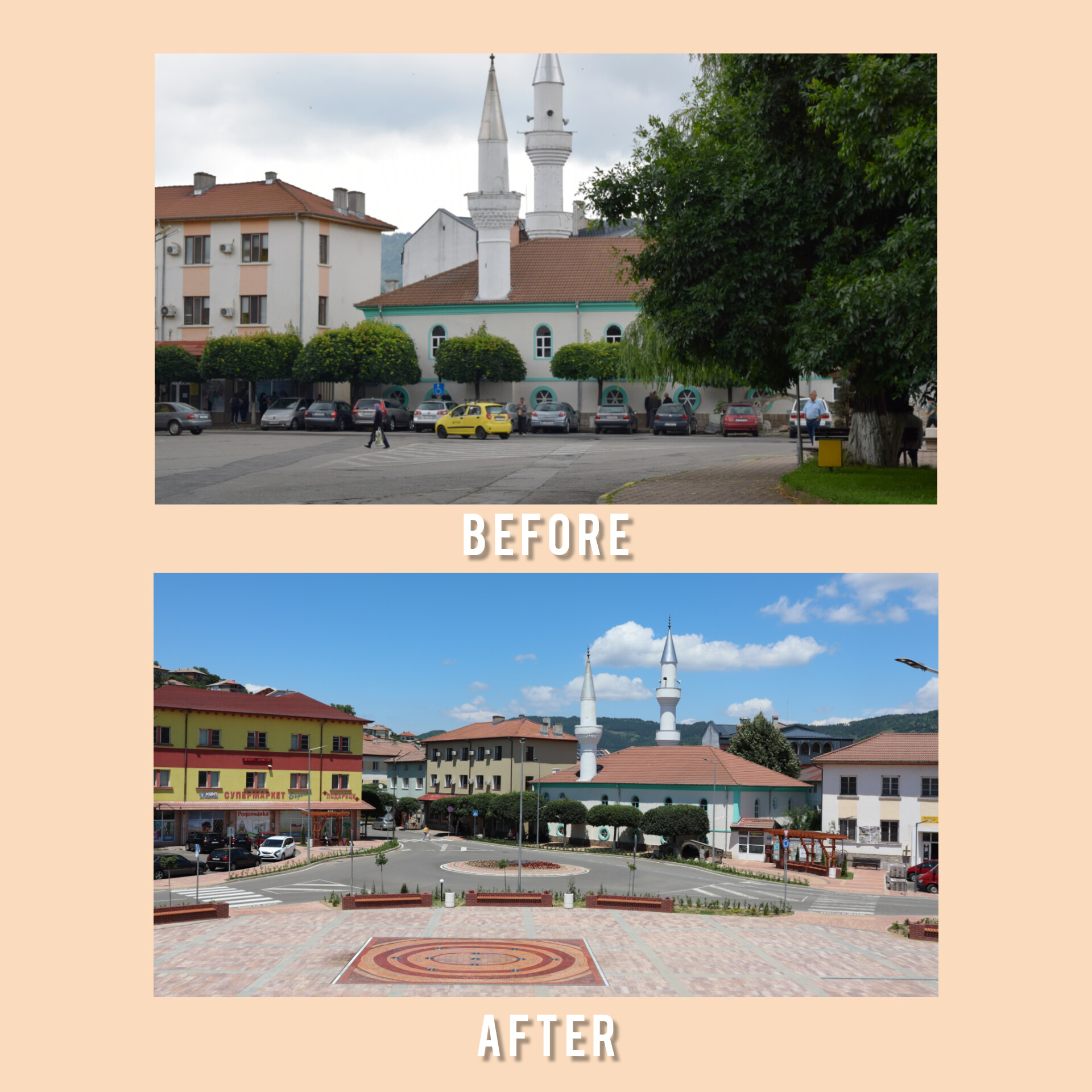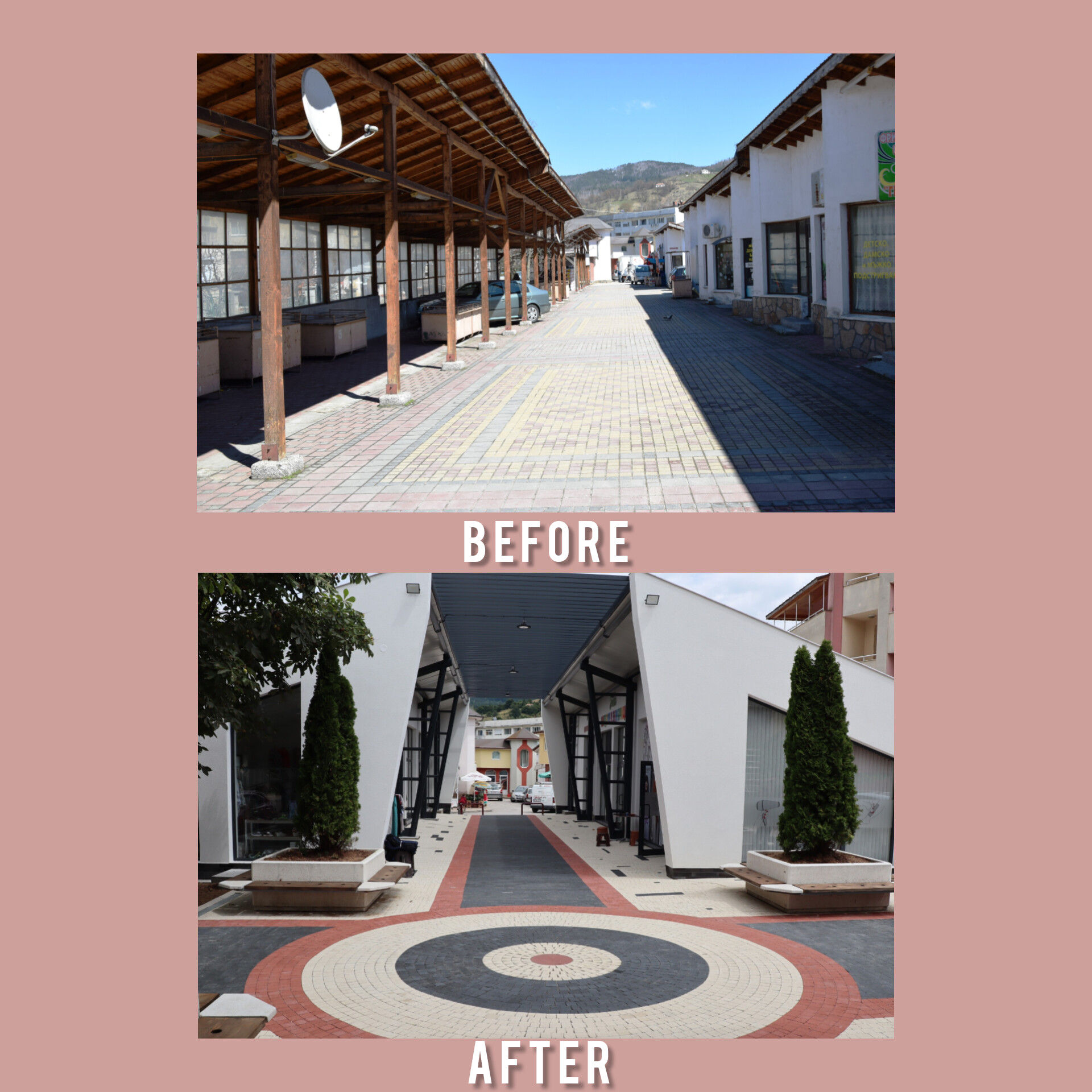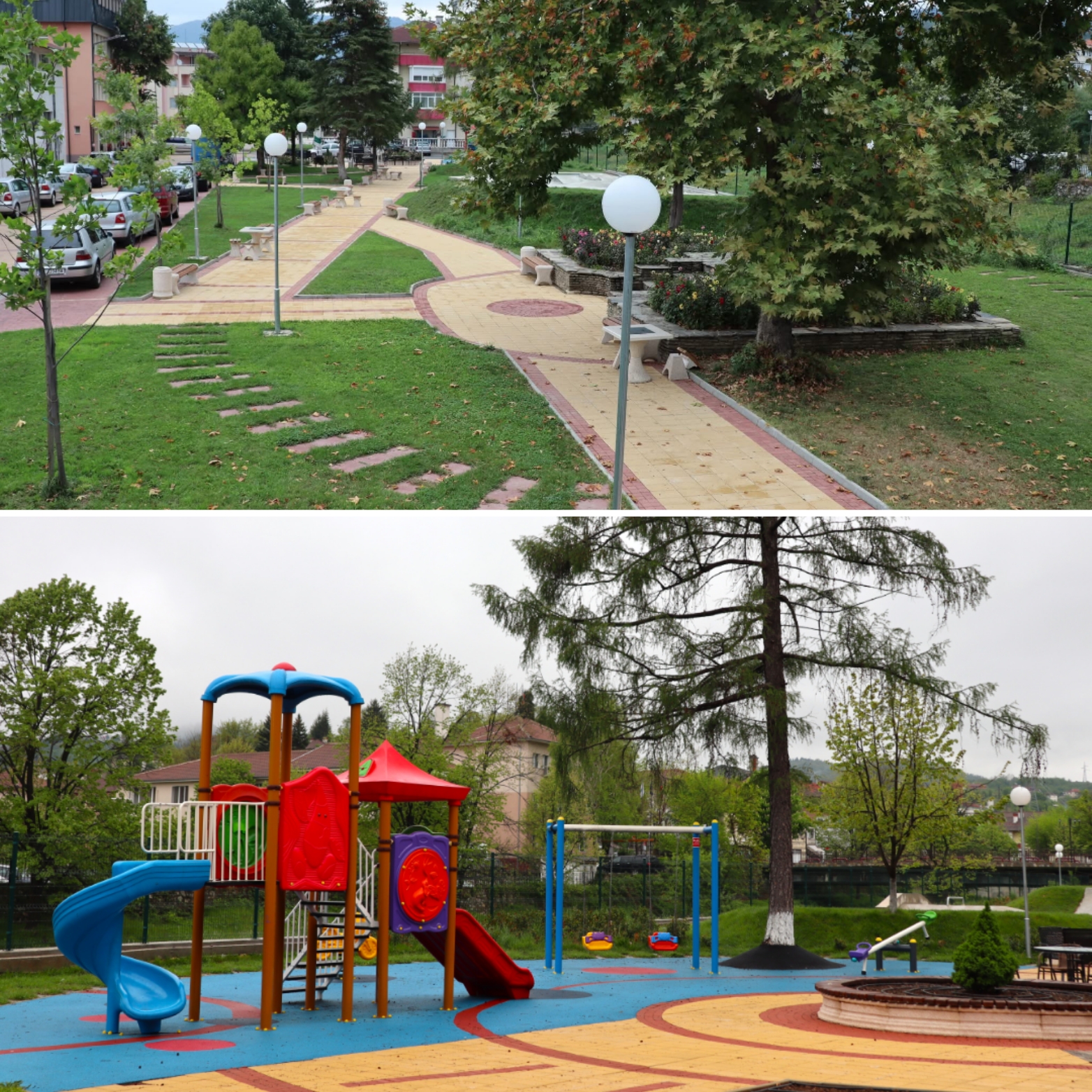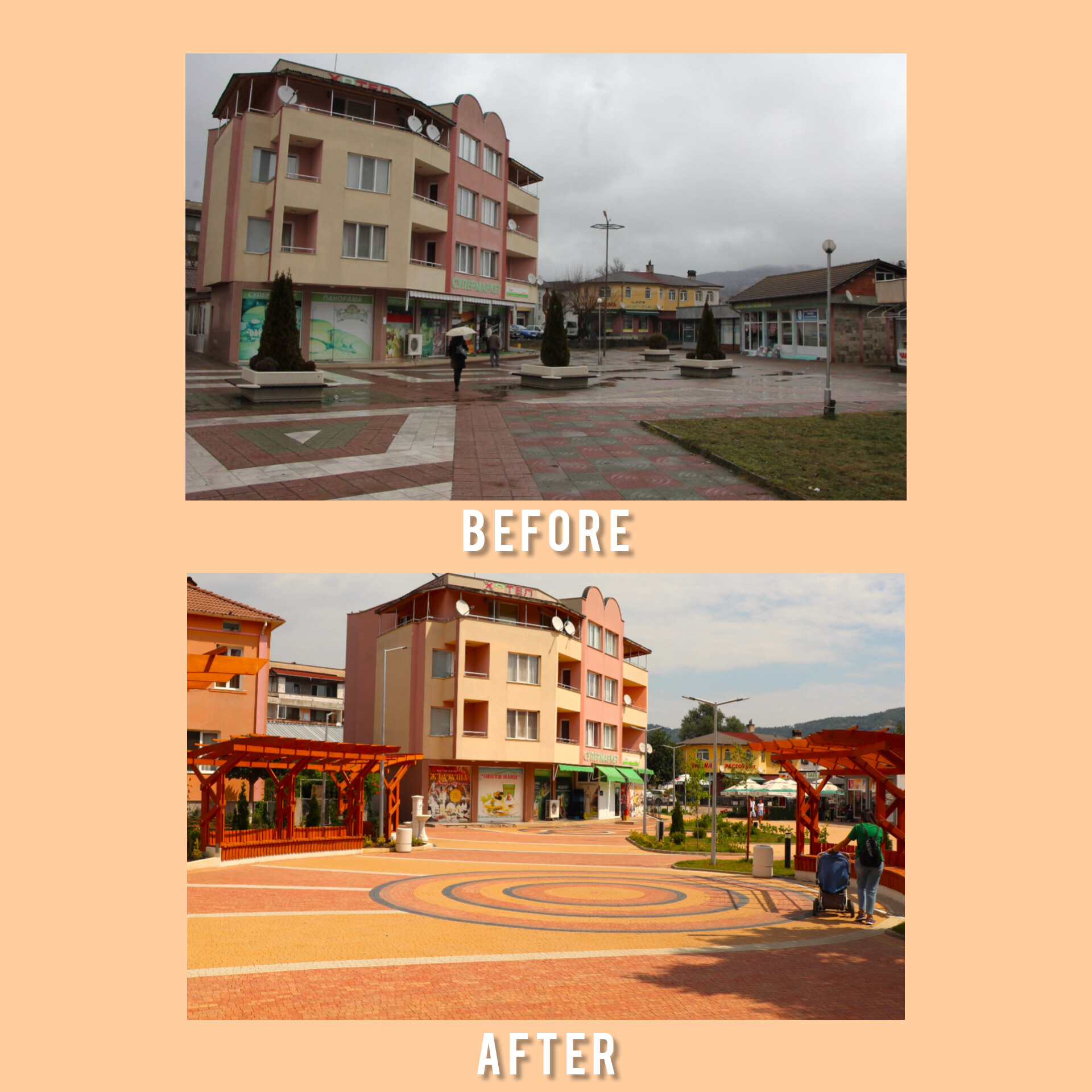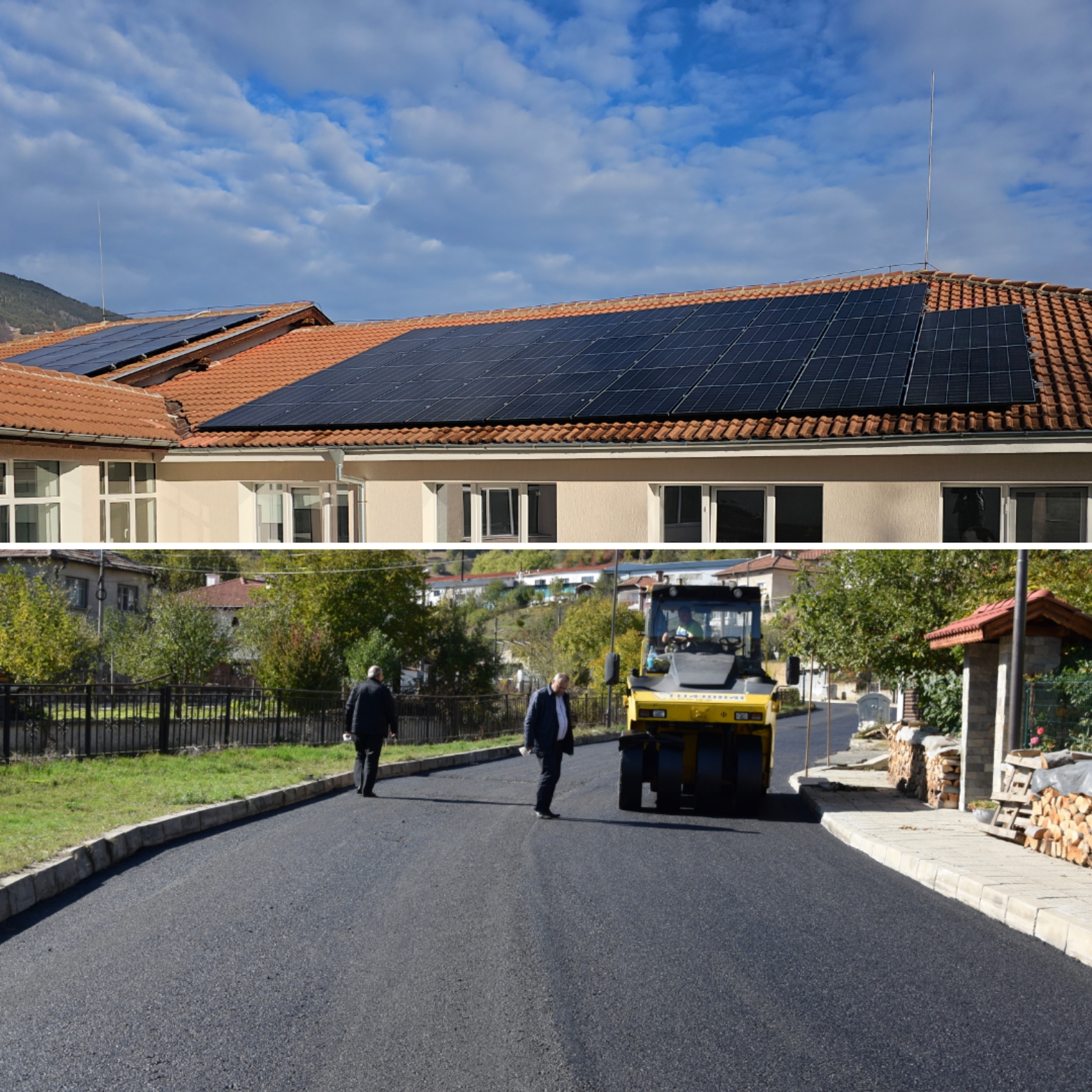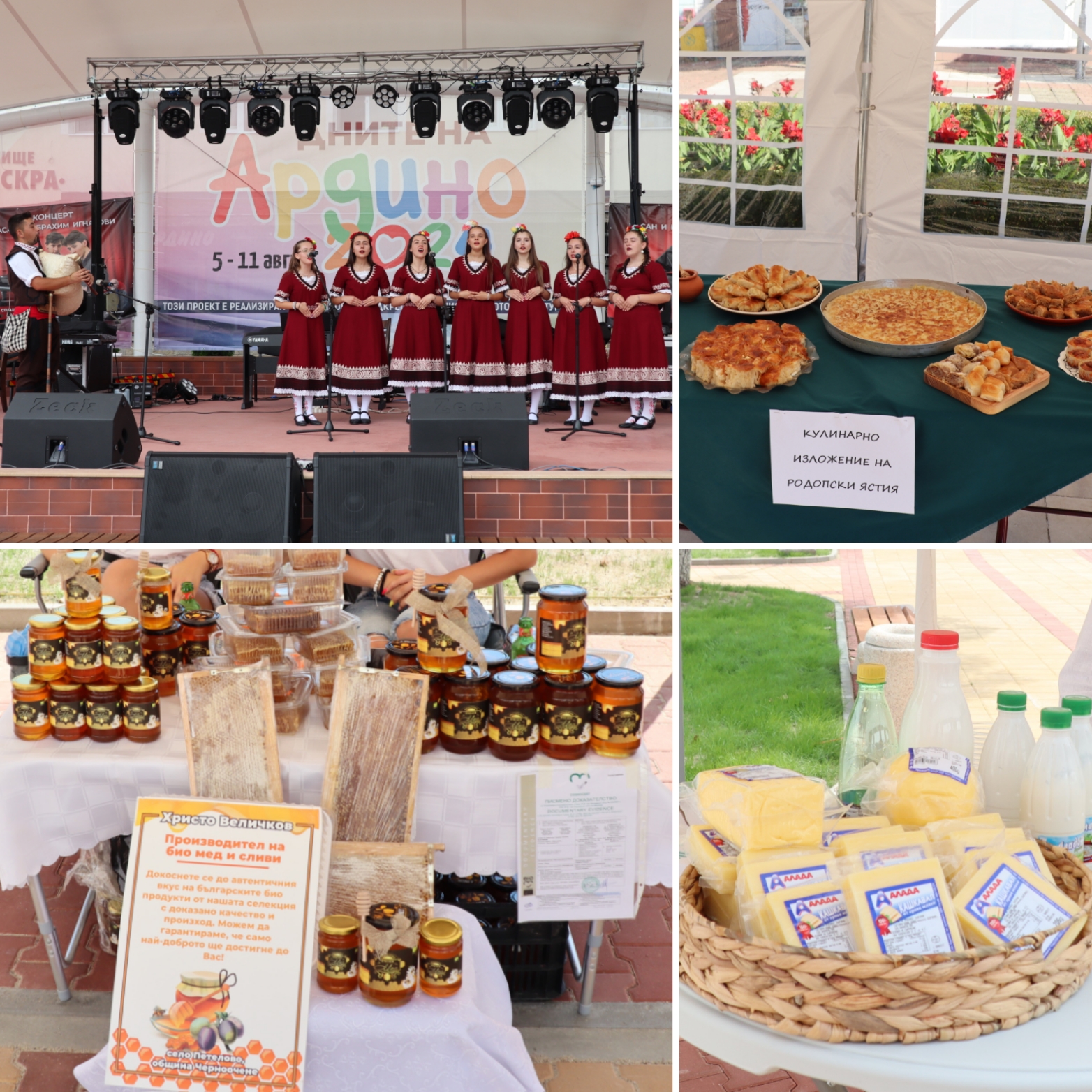"Sustainable revitalization of Ardino"
"Sustainable development and modernization of the town of Ardino for a better urban environment"
The initiative for sustainable development of Ardino includes the revitalization of the central urban area, modernization of public spaces, energy-efficient buildings, and the implementation of green technologies. The completed projects create an accessible and aesthetic environment, stimulate cultural life with festivals and events, and ensure long-term ecological and social well-being for the residents and visitors of the town.
Bulgaria
Town of Ardino
Completed
Yes
Yes
Yes
Yes
1. The project "Improvement of the Central Urban Area of Ardino" was financed through the municipal budget for the period 2021-2023.
2. The project "Reconstruction of the Municipal Market and Extension in Ardino" was implemented with the municipal budget for the period 2022-2023.
3. The project "Revitalization of a Public Park in Ardino, Ardino Municipality" was implemented with European funding through the European Agricultural Fund for Rural Development for the period 2020-2022.
4. The project "Revitalization of a Public Square in Ardino, Ardino Municipality" is being implemented with European funding through the European Agricultural Fund for Rural Development for the period 2023-2024.
5. The project "Construction, Reconstruction, and/or Rehabilitation of New and Existing Streets and Sidewalks, along with Associated Infrastructure in Ardino, Ardino Municipality" was implemented with European funding through the European Agricultural Fund for Rural Development for the period 2019-2022.
No
KRZ02: Ardino (BG)
General goal:
The sustainable development and modernization of the town of Ardino with the aim of creating a functional, ecological, and accessible urban environment that promotes social inclusion, cultural development, and the sustainable use of resources.
Target groups:
• Residents of the town of Ardino, including children, youth, adults, and people with disabilities.
• Local producers and traders working at the renovated municipal market.
• Cultural and sports organizations such as the "Rodopska Iskra" Community Center, the "Yunak" Table Tennis Club, and the "Yunak" Football Club.
• Visitors and tourists attracted by the improved infrastructure and cultural events.
Specific goals:
1. Improvement of urban infrastructure: Revitalization of the central area, construction of a roundabout, parks, playgrounds, and cultural facilities, reconstruction of the municipal market and central streets.
2. Energy efficiency and sustainability: Implementation of photovoltaic systems for electricity generation from renewable energy sources and energy efficiency measures in public buildings.
3. Cultural development: Organizing festivals and events that promote local cultural heritage and social interaction.
4. Social engagement: Involvement of citizens in the planning and implementation processes of the projects.
Expected results:
• Transformation of the central area of Ardino into a modern and aesthetic space.
• Significant reduction in energy costs and the carbon footprint of municipal buildings.
• Strengthening of social integration and cultural exchange through the organization of cultural events such as the "Days of Ardino" and the "Festival of Clean Foods from the Rhodopes."
• Long-term enhancement of the city's resilience to climate change and provision of economic and social benefits for all target groups.
The sustainable development and modernization of the town of Ardino with the aim of creating a functional, ecological, and accessible urban environment that promotes social inclusion, cultural development, and the sustainable use of resources.
Target groups:
• Residents of the town of Ardino, including children, youth, adults, and people with disabilities.
• Local producers and traders working at the renovated municipal market.
• Cultural and sports organizations such as the "Rodopska Iskra" Community Center, the "Yunak" Table Tennis Club, and the "Yunak" Football Club.
• Visitors and tourists attracted by the improved infrastructure and cultural events.
Specific goals:
1. Improvement of urban infrastructure: Revitalization of the central area, construction of a roundabout, parks, playgrounds, and cultural facilities, reconstruction of the municipal market and central streets.
2. Energy efficiency and sustainability: Implementation of photovoltaic systems for electricity generation from renewable energy sources and energy efficiency measures in public buildings.
3. Cultural development: Organizing festivals and events that promote local cultural heritage and social interaction.
4. Social engagement: Involvement of citizens in the planning and implementation processes of the projects.
Expected results:
• Transformation of the central area of Ardino into a modern and aesthetic space.
• Significant reduction in energy costs and the carbon footprint of municipal buildings.
• Strengthening of social integration and cultural exchange through the organization of cultural events such as the "Days of Ardino" and the "Festival of Clean Foods from the Rhodopes."
• Long-term enhancement of the city's resilience to climate change and provision of economic and social benefits for all target groups.
1- Sustainable development
2- Energy efficiency
3- Cultural heritage
4- Social engagement
5- Ecological infrastructure
The initiative for the development of the town of Ardino places sustainability at the core of all undertaken activities, implementing a balanced approach between environmental, social, and economic goals. A key focus is the reduction of the carbon footprint through the implementation of photovoltaic systems for the production of green energy for heating in key public buildings. These measures, combined with energy efficiency, lead to a significant reduction in energy costs and environmental preservation.
Spatial planning and the enhancement of the urban environment are also crucial for the sustainability of the initiative. The revitalized central urban area, newly constructed parks, squares, green spaces, and playgrounds improve the microclimate and provide areas for recreation and socialization. At the same time, the renovated street infrastructure, including an organized roundabout, improves accessibility to public services.
The exemplary nature of the initiative demonstrates how a small municipality can achieve significant results through an integrated approach to sustainable development.
Spatial planning and the enhancement of the urban environment are also crucial for the sustainability of the initiative. The revitalized central urban area, newly constructed parks, squares, green spaces, and playgrounds improve the microclimate and provide areas for recreation and socialization. At the same time, the renovated street infrastructure, including an organized roundabout, improves accessibility to public services.
The exemplary nature of the initiative demonstrates how a small municipality can achieve significant results through an integrated approach to sustainable development.
The initiative for spatial and architectural development in Ardino aims to create an aesthetic and harmonious urban environment that not only meets the functional needs of the residents but also inspires, delights, and connects people. Through careful planning and implementation of projects, such as the revitalization of the central urban area and the creation of new spaces for recreation and cultural events, the town is transformed into a place where aesthetics and quality of life are prioritized.
The creation of a central urban zone with a modern stage for cultural events, spacious parks with appropriate plant species, and colorful pathways creates an environment that evokes positive emotions and encourages social interaction. The streets and squares are renewed with contemporary paving and stylish landscaping, complemented by comfortable seating areas and walking zones. The playgrounds and park spaces are designed to stimulate children's play and imagination, while adults can enjoy peace and comfort.
Cultural events, such as the "Days of Ardino" and the "Festival of Clean Foods from the Rhodopes," held annually since 2021, not only promote local cultural heritage but also create opportunities for personal enrichment and socializing. The stage in the central part of the town is designed with aesthetic highlights and functionality, providing a platform for concerts, theatrical performances, and artistic expressions, contributing to the richness of the cultural life.
The exemplary nature of the initiative is reflected in the integration of aesthetics with cultural identity and modern design. Through these efforts, Ardino is becoming a place that inspires, engages, and creates a sense of belonging, proving that even small towns can be models for quality of life and cultural harmony.
The creation of a central urban zone with a modern stage for cultural events, spacious parks with appropriate plant species, and colorful pathways creates an environment that evokes positive emotions and encourages social interaction. The streets and squares are renewed with contemporary paving and stylish landscaping, complemented by comfortable seating areas and walking zones. The playgrounds and park spaces are designed to stimulate children's play and imagination, while adults can enjoy peace and comfort.
Cultural events, such as the "Days of Ardino" and the "Festival of Clean Foods from the Rhodopes," held annually since 2021, not only promote local cultural heritage but also create opportunities for personal enrichment and socializing. The stage in the central part of the town is designed with aesthetic highlights and functionality, providing a platform for concerts, theatrical performances, and artistic expressions, contributing to the richness of the cultural life.
The exemplary nature of the initiative is reflected in the integration of aesthetics with cultural identity and modern design. Through these efforts, Ardino is becoming a place that inspires, engages, and creates a sense of belonging, proving that even small towns can be models for quality of life and cultural harmony.
The initiative for spatial and architectural development in Ardino places inclusion at the core of its concept, creating an urban environment that is accessible, comfortable, and meets the needs of all citizens, regardless of their age, social status, or physical abilities. The main goal is to build inclusive spaces and management systems that encourage active participation from all groups in the public and cultural life of the town.
All new infrastructure projects have been implemented in accordance with accessibility principles. The spaces in the central part of the town are designed with consideration for people with disabilities, including wide pathways and accessible surfaces.
This approach is also reflected in the management systems of the initiative. The citizens of Ardino were actively involved in the planning and implementation process through public consultations and discussions. These interactions provided residents with the opportunity to express their needs, ideas, and concerns, ensuring that the projects reflect the diversity of the local community.
Cultural events such as the "Days of Ardino" and the "Festival of Clean Foods from the Rhodopes" were also created with the idea of inclusion, combining traditions with modern forms of expression to attract participants and visitors from various age groups and social backgrounds.
Ardino serves as an example of how inclusion can be integrated into all aspects of urban planning - from accessible architecture and design to new models of public interaction. Through these efforts, the town proves that inclusion is not only a goal but also a means of creating a harmonious and just society.
All new infrastructure projects have been implemented in accordance with accessibility principles. The spaces in the central part of the town are designed with consideration for people with disabilities, including wide pathways and accessible surfaces.
This approach is also reflected in the management systems of the initiative. The citizens of Ardino were actively involved in the planning and implementation process through public consultations and discussions. These interactions provided residents with the opportunity to express their needs, ideas, and concerns, ensuring that the projects reflect the diversity of the local community.
Cultural events such as the "Days of Ardino" and the "Festival of Clean Foods from the Rhodopes" were also created with the idea of inclusion, combining traditions with modern forms of expression to attract participants and visitors from various age groups and social backgrounds.
Ardino serves as an example of how inclusion can be integrated into all aspects of urban planning - from accessible architecture and design to new models of public interaction. Through these efforts, the town proves that inclusion is not only a goal but also a means of creating a harmonious and just society.
The initiative for sustainable development in Ardino is built on the principle of actively involving citizens and civil society at all stages - from planning to implementation. This approach ensures that the projects reflect the real needs and desires of the local community, creating a sense of ownership and shared responsibility for the achieved results.
From the conceptual stage, public discussions were organized, allowing citizens to express their ideas and suggestions.
Civil society and local organizations were actively engaged in initiatives related to the preservation of natural resources and cultural heritage. Events such as the "Days of Ardino" and the "Festival of Clean Foods from the Rhodopes" provide a platform for local creators, producers, and artists, strengthening community ties and promoting social interaction. This model of participation led to significant results.
The long-term impact of this participation is the creation of a sustainable and cohesive society, where people feel not only as beneficiaries but also as active participants in the transformation of their town. The model implemented in Ardino demonstrates how involving citizens in decision-making processes and project implementation can achieve sustainable and meaningful results for the entire community.
From the conceptual stage, public discussions were organized, allowing citizens to express their ideas and suggestions.
Civil society and local organizations were actively engaged in initiatives related to the preservation of natural resources and cultural heritage. Events such as the "Days of Ardino" and the "Festival of Clean Foods from the Rhodopes" provide a platform for local creators, producers, and artists, strengthening community ties and promoting social interaction. This model of participation led to significant results.
The long-term impact of this participation is the creation of a sustainable and cohesive society, where people feel not only as beneficiaries but also as active participants in the transformation of their town. The model implemented in Ardino demonstrates how involving citizens in decision-making processes and project implementation can achieve sustainable and meaningful results for the entire community.
The initiative for spatial and architectural development in Ardino has been created and implemented through active involvement of various stakeholders at different levels - local, regional, national, and European. Each of these levels plays a key role in providing the resources, support, and expertise necessary for the successful realization of the projects.
At the local level, key participants are the citizens of Ardino and local institutions. Citizens are actively involved in the planning process through public discussions that allow for the collection of proposals and the identification of needs. Local organizations and businesses are also engaged, participating in cultural events and local initiatives, as well as executing some of the infrastructure activities, such as construction companies and service providers.
Regional and national levels of governance are linked to providing financial and technical support for the initiative. Through projects funded by European and national funds, resources are allocated for energy renovations of public buildings and infrastructure.
At the national level, state institutions and ministries provide strategic guidance and legislative frameworks. The Ministry of Culture provided financial support for the organization of the "Days of Ardino" and the "Festival of Clean Foods from the Rhodopes" in 2024.
At the European level, European funds play a significant role in securing resources for infrastructure renewal, as well as implementing green and energy-efficient solutions.
Thus, through coordinated efforts and active participation at all levels, from local residents to European institutions, the successful realization of the initiative is achieved, serving as an example of synergy and sustainable development.
At the local level, key participants are the citizens of Ardino and local institutions. Citizens are actively involved in the planning process through public discussions that allow for the collection of proposals and the identification of needs. Local organizations and businesses are also engaged, participating in cultural events and local initiatives, as well as executing some of the infrastructure activities, such as construction companies and service providers.
Regional and national levels of governance are linked to providing financial and technical support for the initiative. Through projects funded by European and national funds, resources are allocated for energy renovations of public buildings and infrastructure.
At the national level, state institutions and ministries provide strategic guidance and legislative frameworks. The Ministry of Culture provided financial support for the organization of the "Days of Ardino" and the "Festival of Clean Foods from the Rhodopes" in 2024.
At the European level, European funds play a significant role in securing resources for infrastructure renewal, as well as implementing green and energy-efficient solutions.
Thus, through coordinated efforts and active participation at all levels, from local residents to European institutions, the successful realization of the initiative is achieved, serving as an example of synergy and sustainable development.
The initiative for spatial and architectural development in Ardino is a multidisciplinary project that brings together various fields of knowledge and professional disciplines with the aim of creating a sustainable and aesthetically appealing urban environment. These disciplines include architecture, ecology, social sciences, cultural heritage, engineering, and energy efficiency, which jointly form the foundation for the implementation of the initiative.
Architecture plays a central role in the design of new urban spaces. Architects work closely with local authorities to create functional and beautiful public spaces that meet the needs of the local population.
Ecology and sustainable development are integrated into the design of the initiative, using principles of energy efficiency and sustainable management of natural resources. The projects include the creation of green spaces with appropriate plant species, waste and water management systems, as well as the installation of photovoltaic systems for heating, which reduce carbon emissions and energy costs for buildings. Environmental experts and engineers play a key role in planning and implementing these solutions.
Cultural heritage and local identity are also integrated into the initiative, with cultural experts ensuring the preservation of the traditions and authenticity of the town. Throughout the process, the historical and cultural characteristics of Ardino are considered, combining contemporary architectural language with respect for the past.
The added value of this multidisciplinary approach is the creation of a comprehensive and sustainable urban concept that not only meets the needs of modern residents but also preserves and highlights the uniqueness of the local culture and natural resources.
Architecture plays a central role in the design of new urban spaces. Architects work closely with local authorities to create functional and beautiful public spaces that meet the needs of the local population.
Ecology and sustainable development are integrated into the design of the initiative, using principles of energy efficiency and sustainable management of natural resources. The projects include the creation of green spaces with appropriate plant species, waste and water management systems, as well as the installation of photovoltaic systems for heating, which reduce carbon emissions and energy costs for buildings. Environmental experts and engineers play a key role in planning and implementing these solutions.
Cultural heritage and local identity are also integrated into the initiative, with cultural experts ensuring the preservation of the traditions and authenticity of the town. Throughout the process, the historical and cultural characteristics of Ardino are considered, combining contemporary architectural language with respect for the past.
The added value of this multidisciplinary approach is the creation of a comprehensive and sustainable urban concept that not only meets the needs of modern residents but also preserves and highlights the uniqueness of the local culture and natural resources.
The initiative for spatial and architectural development in Ardino presents innovations that distinguish it from mass practices in urban development and architecture. It is based on a holistic approach for sustainable, inclusive, and aesthetically sound urban renewal, integrating modern solutions within the context of Ardino’s unique characteristics and the needs of its residents.
One of the main innovative aspects is the integration of energy-efficient technologies at the local level. Projects related to photovoltaic systems for autonomous power supply are aimed at reducing carbon emissions and ensuring a sustainable energy infrastructure.
Another innovative element is the approach to restoring and renewing public spaces in accordance with the principles of sustainable urban planning. While there are examples of the reconstruction of central urban areas, the initiative in Ardino includes interactive and multifunctional spaces that provide opportunities for cultural activities. This is not just a simple renovation of public areas, but the creation of new spaces for public interaction and sustainable social development.
Innovation is also evident in the approach to citizen participation in the planning and implementation processes. Involving the local community from the very beginning is a step toward creating a new management model, in which citizens are not merely passive observers, but active participants in shaping their surroundings. The cultural events program is also an innovation. These events, which combine cultural heritage with ecologically clean food production, offer not only tourism and economic benefits but also emphasize the sustainable development of local resources.
All these innovations place the initiative within the context of innovative approaches to urban development and the sustainable management of public spaces.
One of the main innovative aspects is the integration of energy-efficient technologies at the local level. Projects related to photovoltaic systems for autonomous power supply are aimed at reducing carbon emissions and ensuring a sustainable energy infrastructure.
Another innovative element is the approach to restoring and renewing public spaces in accordance with the principles of sustainable urban planning. While there are examples of the reconstruction of central urban areas, the initiative in Ardino includes interactive and multifunctional spaces that provide opportunities for cultural activities. This is not just a simple renovation of public areas, but the creation of new spaces for public interaction and sustainable social development.
Innovation is also evident in the approach to citizen participation in the planning and implementation processes. Involving the local community from the very beginning is a step toward creating a new management model, in which citizens are not merely passive observers, but active participants in shaping their surroundings. The cultural events program is also an innovation. These events, which combine cultural heritage with ecologically clean food production, offer not only tourism and economic benefits but also emphasize the sustainable development of local resources.
All these innovations place the initiative within the context of innovative approaches to urban development and the sustainable management of public spaces.
The methodology used in the initiative is based on an integrated approach that combines sustainable urban planning, local community participation, and innovative ecological solutions. It is tailored to the specific needs of the population and the principles of sustainable development, ensuring long-term effectiveness and a positive impact on both the environment and society.
The core approach of the project integrates social, ecological, and economic aspects into a unified concept. At the outset of the process, a detailed study of the citizens' needs and preferences is carried out through public discussions of the project ideas, which form the basis for decision-making. This approach ensures that the projects address the real and current needs of the residents, rather than just technical and architectural requirements.
The projects for urban infrastructure renewal and the creation of new public spaces apply the principles of sustainable urban planning and energy efficiency. The inclusion of renewable energy technologies, such as photovoltaic panels and heat pumps, is fundamental to the concept of reducing carbon emissions and energy costs. At the same time, projects for green spaces and the creation of nature-friendly environments are implemented to improve the quality of life in the urban setting.
An important aspect of the methodology is also collaboration with European partners and the use of European funds and programs. This provides access to innovations and best practices that can be adapted to local conditions, while ensuring that the projects align with broader goals for sustainable development set at the European level.
This complex and integrated methodology ensures a balanced and sustainable approach to the development of Ardino, while meeting contemporary requirements for sustainability, inclusion, and aesthetics.
The core approach of the project integrates social, ecological, and economic aspects into a unified concept. At the outset of the process, a detailed study of the citizens' needs and preferences is carried out through public discussions of the project ideas, which form the basis for decision-making. This approach ensures that the projects address the real and current needs of the residents, rather than just technical and architectural requirements.
The projects for urban infrastructure renewal and the creation of new public spaces apply the principles of sustainable urban planning and energy efficiency. The inclusion of renewable energy technologies, such as photovoltaic panels and heat pumps, is fundamental to the concept of reducing carbon emissions and energy costs. At the same time, projects for green spaces and the creation of nature-friendly environments are implemented to improve the quality of life in the urban setting.
An important aspect of the methodology is also collaboration with European partners and the use of European funds and programs. This provides access to innovations and best practices that can be adapted to local conditions, while ensuring that the projects align with broader goals for sustainable development set at the European level.
This complex and integrated methodology ensures a balanced and sustainable approach to the development of Ardino, while meeting contemporary requirements for sustainability, inclusion, and aesthetics.
The initiative for spatial and architectural development of Ardino possesses significant potential for replication and transfer to different contexts and other beneficiary groups. The methodology of active citizen participation in the design and implementation of projects can easily be applied in other municipalities, where surveys, consultations, and public meetings ensure that the projects meet the needs of local residents. The technologies used to achieve energy efficiency and reduce carbon emissions, such as photovoltaic panels and heat pumps, can be transferred to other settlements with similar needs, adapting them to specific climatic and infrastructural conditions.
The projects for the reconstruction of public spaces - parks, squares, and pedestrian zones - can also be adapted in other small and medium-sized cities, creating new social spaces for local communities. Cultural initiatives that combine ecological products and local traditions can be replicated in other regions, supporting the development of local tourism and economy.
The interdisciplinary approach to project management, involving architects, engineers, ecologists, and social experts, can be transferred to other urban transformation projects, ensuring more comprehensive and sustainable solutions. All these elements of the initiative offer a model for sustainable and inclusive development that can be adapted in different contexts and have a long-term impact on the social, economic, and environmental sustainability of other regions.
The projects for the reconstruction of public spaces - parks, squares, and pedestrian zones - can also be adapted in other small and medium-sized cities, creating new social spaces for local communities. Cultural initiatives that combine ecological products and local traditions can be replicated in other regions, supporting the development of local tourism and economy.
The interdisciplinary approach to project management, involving architects, engineers, ecologists, and social experts, can be transferred to other urban transformation projects, ensuring more comprehensive and sustainable solutions. All these elements of the initiative offer a model for sustainable and inclusive development that can be adapted in different contexts and have a long-term impact on the social, economic, and environmental sustainability of other regions.
The initiative for spatial and architectural development of Ardino addresses a range of global challenges by providing local solutions that create a sustainable and inclusive urban environment. One of the main global challenges faced by contemporary society is climate change. The initiative in Ardino successfully tackles this challenge through the implementation of energy-efficient technologies, such as photovoltaic panels and heat pumps, which reduce carbon emissions and dependency on traditional energy sources. These measures not only decrease the ecological footprint of buildings and infrastructure in the municipality but also support the transition to renewable energy sources and sustainable resource management.
Another significant global issue is growing social inequality and the exclusion of certain groups from public processes. In Ardino, concrete steps are being taken to address these challenges through inclusive project management, which ensures citizen participation in the planning and implementation processes.
Furthermore, the city is successfully addressing urban challenges, such as the renewal of public spaces and infrastructure for culture and recreation. This not only improves the quality of life but also creates new social and economic opportunities. Through these development efforts, Ardino demonstrates how local initiatives can enhance citizens' lives and contribute to building a sustainable society.
The initiative for Ardino is an example of how local solutions can respond to global problems, such as climate change, social isolation, and resource management. By integrating sustainable technologies and inclusive practices into urban planning, the project provides innovative solutions to address these global challenges while simultaneously strengthening the community.
Another significant global issue is growing social inequality and the exclusion of certain groups from public processes. In Ardino, concrete steps are being taken to address these challenges through inclusive project management, which ensures citizen participation in the planning and implementation processes.
Furthermore, the city is successfully addressing urban challenges, such as the renewal of public spaces and infrastructure for culture and recreation. This not only improves the quality of life but also creates new social and economic opportunities. Through these development efforts, Ardino demonstrates how local initiatives can enhance citizens' lives and contribute to building a sustainable society.
The initiative for Ardino is an example of how local solutions can respond to global problems, such as climate change, social isolation, and resource management. By integrating sustainable technologies and inclusive practices into urban planning, the project provides innovative solutions to address these global challenges while simultaneously strengthening the community.
The initiative for development of Ardino continues with the goal of long-term sustainability, social inclusion, and an aesthetically appealing environment, integrating the values of the NEB – sustainability, aesthetics, and inclusion.
Measures are planned, such as the construction of renewable energy infrastructure, including photovoltaic panels on public buildings and the renovation of multi-family residential buildings, which will reduce carbon emissions and improve energy efficiency.
The improvement of the city center includes the creation of new public spaces – playgrounds, relaxation zones, beautification of the riverbank area of the Ardinitsa River with a water mirror, and the construction of several facilities in the area of the closed military unit in the central urban area, which will enrich Ardino's urban environment. This will enhance the quality of the urban space by providing green and aesthetically pleasing spaces. Traditional events such as the "Days of Ardino" and the "Festival of Clean Foods from the Rhodopes" will continue to unite local producers, creators, and the community through cultural and ecological initiatives, promoting the region.
The principles of sustainability, aesthetics, and inclusion will be implemented through ecological technologies, accessible and beautiful spaces, as well as active citizen participation in the creation and transformation of the urban environment.
The next steps include the use of sustainable technologies, creative cultural projects, and active civic participation. This will ensure the creation of a sustainable and inclusive urban environment, with the involvement of stakeholders remaining a key factor in planning and implementation processes.
The ongoing development of the initiative will strengthen Ardino’s position as a model for innovation in sustainable urban development and will demonstrate how local actions can address global challenges such as climate change and social isolation.
Measures are planned, such as the construction of renewable energy infrastructure, including photovoltaic panels on public buildings and the renovation of multi-family residential buildings, which will reduce carbon emissions and improve energy efficiency.
The improvement of the city center includes the creation of new public spaces – playgrounds, relaxation zones, beautification of the riverbank area of the Ardinitsa River with a water mirror, and the construction of several facilities in the area of the closed military unit in the central urban area, which will enrich Ardino's urban environment. This will enhance the quality of the urban space by providing green and aesthetically pleasing spaces. Traditional events such as the "Days of Ardino" and the "Festival of Clean Foods from the Rhodopes" will continue to unite local producers, creators, and the community through cultural and ecological initiatives, promoting the region.
The principles of sustainability, aesthetics, and inclusion will be implemented through ecological technologies, accessible and beautiful spaces, as well as active citizen participation in the creation and transformation of the urban environment.
The next steps include the use of sustainable technologies, creative cultural projects, and active civic participation. This will ensure the creation of a sustainable and inclusive urban environment, with the involvement of stakeholders remaining a key factor in planning and implementation processes.
The ongoing development of the initiative will strengthen Ardino’s position as a model for innovation in sustainable urban development and will demonstrate how local actions can address global challenges such as climate change and social isolation.

